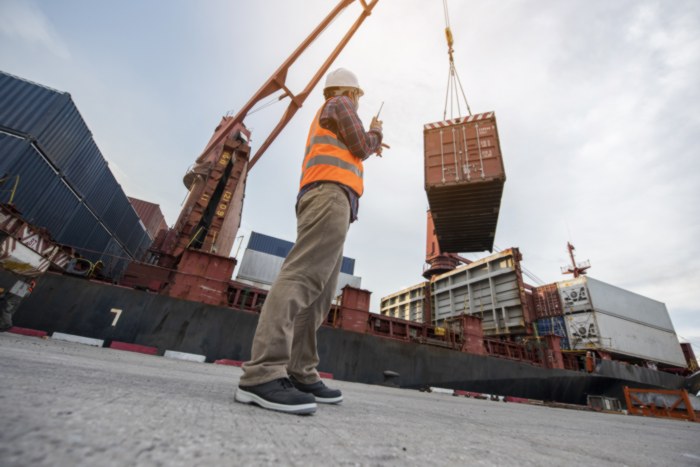
Cranes play a key role across many industries, but perhaps one sector that heavily relies on these types of cranes is the container shipping sector. Cranes are of utmost importance in the container shipping and logistics industry, where they are used for loading and unloading containers from ships, lorries and railcars. Types of container crane, like lifting cranes, make the handling of containers faster, more efficient and reduces the time taken for cargo to reach its destination. With the growth of global trade, the demand for shipping container cranes has increased. As a result, a wide range of cranes has been developed to handle the specific tasks within the container shipping and logistics industry.
In this blog post, we’ll explore the different types of container cranes used in shipping and logistics and how they can be used to move containers safely and effectively.
Overhead Cranes
Overhead cranes, also known as bridge cranes, are a common ship crane type, although they are perhaps spotted more frequently in industrial manufacturing settings. The trolley – connected to the hoist – glides along the bridge, allowing the hoist to precisely position loads anywhere within the crane’s coverage area. Overhead cranes are typically used for loading and unloading containers from trucks and railcars, as well as for stacking containers.
Gantry Cranes
Gantry cranes are frequently used in container yards, where containers are stored before being shipped to their final destinations. Container gantry cranes run on tracks that are mounted on the ground and use an overhead bridge to move containers from one location to another. They are best suited to large yards and can handle containers of various sizes, including 20-foot and 40-foot containers.
Gantry cranes come in two types: rail-mounted gantry cranes (RMGs) and rubber-tyred gantry cranes (RTGs). RMGs run on rails that are fixed to the ground, whilst RTGs run on rubber wheels and can move on concrete surfaces. RMGs are more stable and can handle heavy loads, while RTGs are more flexible and can move in different directions, making them ideal for stacking containers in tight spaces. They use hydraulic and electrical systems to lift and move containers and can be operated by one operator.
Ship-to-Shore Cranes
Ship-to-shore cranes (STS) are used to load and unload containers from ships. These heavy-lifting cranes are located at terminals and are designed to handle containers of various sizes and weights. They use a combination of hydraulic and electrical systems to move containers from ships to the terminal and vice versa.
STS cranes come in two types: mobile harbour cranes and fixed cranes. Mobile harbour cranes are mounted on rubber tyres and can move from one ship to another, whilst fixed cranes are permanently installed at the terminal and cannot move from their location. Fixed cranes are larger and can handle heavy loads, whilst mobile cranes are more flexible and can be used in different locations around a site.
Mobile Cranes
Mobile cranes are used for various tasks within the container shipping and logistics sector, including loading and unloading containers from ships, lorries and railcars. Vehicle-mounted cranes consist of a telescopic boom and a cabin mounted on rubber tyres. This provides them with the versatility of being driven from one location to another. Mobile cranes are ideally suited to small yards and can handle containers of various sizes. They are flexible and can move in different directions, making them ideal for stacking containers in tight spaces. Mobile cranes versatility allows them to be easily repositioned, these types of cranes are also ideal for carrying out structural repairs, construction and infrastructure tasks and jobs that require flexibility.
Floating Cranes
Floating cranes are often used in ports and terminals to load and unload containers from ships. These shipping cranes are mounted on a floating platform, which can be moved into position directly next to the ship for ease of cargo transfer. Floating cranes are typically used for loading and unloading containers from ships that are too big to be moved using traditional cranes. They are also used in ship building and to assemble structures at sea, such as oil platforms and wind farms.
Rail-Mounted Cranes
Rail-mounted cranes are a specific type of crane that operates on a permanent track system. These specialised machines are essential for intermodal freight operations, particularly at rail yards and ports. By moving along a fixed track, they can efficiently and precisely load and unload heavy containers from railcars and ships, making them a crucial component in the global logistics and supply chain network.
Mobile crane hire for the logistics sector
Cranes play a critical role in the container shipping and logistics sector, and the use of different types of cranes has made the handling of containers faster and more efficient. Although, there are a great number of highly specialised types of cranes, mobile cranes can often provide a highly versatile lifting solution as an additional resource, fulfilling several different functions around a site.
If you would like to learn more about the types of container cranes or mobile crane hire for your site or project, speak to us today. As one of the country’s most trusted crane hire companies, Emerson Cranes is highly experienced in the complexities of lifting operations in a diverse number of industries. Call us on 020 8548 3900 to discuss your mobile crane hire needs in more detail, or click to visit our contact page.


